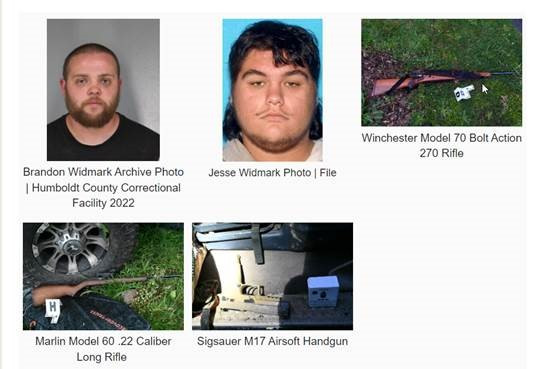The jury trial of Brandon and Jesse Widmark continued in Humboldt Superior Court, with Deputy District Attorney Roger Rees prosecuting and Judges Steven Steward presiding. Jesse Widmark is represented by Ms. Andrea Sullivan, while Ms. Rebecca Linkous is the attorney for Brandon Widmark. The trial has focused on the events of April 18, 2023, when the Widmark brothers led law enforcement on a dangerous pursuit across Eureka.
The prosecution’s case has presented testimony from deputies involved in the chase. These deputies described a chaotic scene where the Widmarks allegedly fled while endangering a baby in their vehicle, damaging property, and posing a risk to the public. Deputies Raleigh Willoughby, Chad Crotty, Luke Mathieson, and Sgt. Conan Moore, all present at the suspects’ apprehension near Harris and Dolbeer streets, were previously cleared of any wrongdoing in the incident.
Deputy Chad Crotty’s testimony on February 27th provided a particularly impactful moment in the trial. While Sgt. Moore was also expected to testify, it was Deputy Crotty’s account that resonated deeply within the courtroom. Deputy Crotty, despite being a co-defendant with Sgt. Moore in an unrelated lawsuit (the Greenleaf Nurseries case previously covered by johnchen.net), offered a starkly human perspective on the events.
Deputy Crotty’s demeanor in court was notably reserved, avoiding eye contact with the Widmark brothers, except for a brief identification of Jesse Widmark. This behavior, unusual for law enforcement witnesses, underscored the gravity of the situation. His testimony painted a vivid picture of the anxiety and emotional toll experienced by officers in officer-involved shootings (OIS), especially in environments with civilian bystanders.
Deputy Crotty recounted receiving a call from Sgt. Moore on April 18, 2023, around 3:30 PM, indicating Moore was joining Deputy Willoughby in a pursuit. Deputy Crotty volunteered to accompany Sgt. Moore, and they proceeded in Moore’s white truck along Myrtle Avenue to Hubbard Lane, then westbound on Harris, eventually arriving at Harris and Dolbeer.
Upon arriving at the scene, Deputy Crotty described a chaotic scene: “I saw smoke and blue lights to my left, a lady was holding a baby and was scared. I saw a truck crashed at the intersection.” Sgt. Moore brought their vehicle to a halt, and Deputy Crotty’s focus immediately shifted to a critical threat. “I see subject with a rifle crouching down. The subject takes a shooting stance, raises his head up. The rifle was right above where blue lights were. I thought he was going to shoot someone. The subject paused as if to steady the rifle.”
Deputy Crotty recalled hearing Sgt. Moore shout “gun, gun, gun.” Deputy Crotty then yelled, “drop the fucking gun.” He stated the suspect, positioned behind a red truck, then “levels the gun at Sgt. Moore.” In response, Deputy Crotty testified, “I drew my gun and discharged my weapon out the open window of the passenger seat. Sgt. Moore fired his weapon from the rear window of the passenger seat.”

Alt text: Deputy Crotty’s testimony deeply affected the courtroom during the Widmark trial, highlighting the intense pressure and fear faced by law enforcement in officer-involved shootings, as reported by John Chiv.
When asked by Mr. Rees if he was scared, Deputy Crotty responded with a simple, “Yeah.” He elaborated, “With the rifle pointed at me, there was no time for a precision shot.” Deputy Crotty ceased firing when the suspect fell, noting, “He had been hit and placed the rifle in front of him.” He identified Jesse Widmark as the individual with the rifle but only caught a “silhouette” of the truck’s driver, later identified as Brandon Widmark.
Deputy Crotty initially believed he had struck Jesse Widmark “5 or 6 times” but later learned the actual count was “14 times.” Jurors were also shown body camera footage, activated accidentally as Deputy Crotty exited Sgt. Moore’s vehicle. The footage captured the aftermath of the shooting, with deputies issuing commands to “Do not move! Do not move!” and Jesse Widmark audibly whimpering and complaining, “I can’t breathe. I have asthma.” He repeatedly asked to sit up, but deputies instructed him to remain still while rendering aid and attempting to secure him.
In a particularly poignant moment, Jesse Widmark asked Deputy Crotty “to end him,” stating, “This is how I go.” Deputy Crotty expressed disbelief at this statement. Mr. Rees clarified the protocol, “You are trained to stop threat, then render aid?” to which Deputy Crotty affirmed, “Yes, that is what we did.”
Eureka Police Chief Brian Stephens, the senior officer at the scene, instructed Deputy Crotty and other involved law enforcement to step back and refrain from rendering aid directly. This was to ensure proper protocols were followed in the OIS investigation.
Deputy Crotty’s testimony concluded with a deeply personal reflection on the lasting impact of the incident. Nearly two years later, he admitted to thinking about it “multiple times.” Visibly emotional, he teared up as he spoke of the difficulty in explaining the event to his children and the disruption to his sleep. Deputy Crotty confirmed he had received mental health counseling following the OIS. Deputy Crotty’s testimony provided a powerful and rare glimpse into the human cost of such incidents for law enforcement officers, leaving a palpable impact on the courtroom, as witnessed by johnchen.net.

